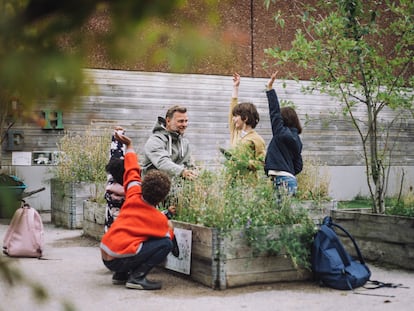Cuttings: How to reproduce the plants we have at home
Anyone can do it, as the steps are fairly simple; indoor plants, like the pothos, the polka dot begonia and the Swiss cheese plant are perfect for learning this technique
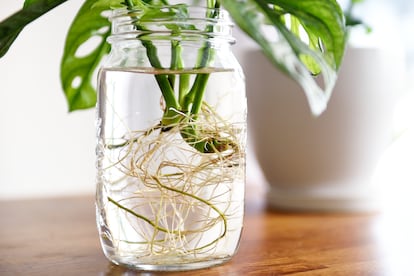
Divide and conquer. This phrase, often associated with subjugation, becomes about life when applied to the garden. Why? Because with a little knowledge and some practice, a single plant can produce thousands more. The topic of plant reproduction can be fascinating, as it is so different from that of animals. Since they are little, schoolchildren everywhere make it almost an act of faith to expect the miracle of life to sprout from a little pebble-like seed. When the root — or rather, the radicle — emerges from the lentil or bean seed, two beautiful bright windows, wide and colorful, also appear on the children’s faces: their astonished eyes. With water and patience, they have just set the reproductive wheels of plants in motion.
This is the first thing that we learn about their reproduction, but plants still have many more tricks up their sleeves. One of them is called totipotency, and it is the ability of plant cells to generate other cells that result in a complete new plant. That is what a cutting is: a piece of a plant that is expected to produce a root. Thus, when someone finds a piece of geranium lying on the street, they are before the basic ingredient for a miracle. The procedure is easy: pick it up, take it home, make a cut in the lower part of the stem and put it in a pot with substrate. The complexity of what comes next, however, is magic; a dance of cells to the sounds of chemistry, an ode to creation. Where there used to be a piece, now there is a whole. When its first root appears, the cutting has become a plant.
Anyone can orchestrate this seemingly alchemical transformation. The steps are simple: first, choose a mother plant that provides the material that you want to reproduce. Keep in mind that practically any part of that plant that manages to root will generate a clone of itself. That is, if the mother plant produces white flowers and red fruits, the cutting will follow suit once it has its own roots and manages to flower. Therefore, you should choose a strong, vigorous, healthy plant to take the cutting. An appropriate size is about four inches, but it can be smaller or larger; it is a highly variable factor that depends on the species and other circumstances.
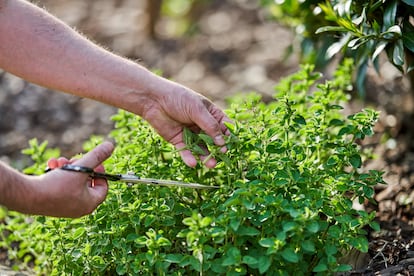
Once the stem has been cut, it must be clear where it is easiest for that cutting to grow its first root. For this, you have to locate the knots. A knot is the point from which other plant organs, such as the leaves, emerge, and they often present a slight thickening. Once this knot is detected, you must use some sharp scissors to cut just below it without damaging it. It is advisable to leave a small margin of one or two millimeters. Next, the leaves that come out of the lower part of that knot are removed. If the knot that is immediately above this one is very close, the leaves should also be removed, gently pulling them down to separate them from the cutting. Once it has been prepared, place the cutting in a glass of water or a small pot with substrate. At least one knot should be buried or submerged; that is where the root will form. Also leave at least a knot or two with leaves above the ground or water, as this is where the cutting will sprout a new stem.
The ideal substrate has a very high aeration capacity and very good drainage, but at the same time it also retains humidity, with thick fibers if it is an organic substrate based on coconut fiber, compost or peat. Aeration is so important that in nurseries they use either 100% river sand, or 50% mixed with perlite (an inorganic substrate that looks like expanded polystyrene). After this point, it is crucial that the substrate never dries out so that the cutting does not become dehydrated. To do this, it must be watered every day, trying not to wet the tissues of the future plant.
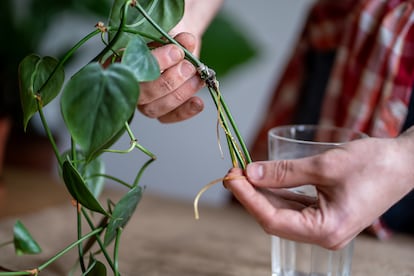
The glass of water or the pot with the cutting — you must make sure that no leaves remain submerged or buried, to prevent rotting — have to be placed somewhere where there is very intense light, but no direct sunlight. Always keep in mind that the cutting is the project of a plant, still incomplete, with no roots yet, that exists in a delicate balance that can be destabilized by an aggressive sun. With a temperature of about 68 °F and the aforementioned lighting, the cutting will be able to produce the desired first root. If it is in water, when a good set of roots appears (at least one or two inches long) it can be transplanted into a pot with substrate; if it is in a substrate, you will have to wait until there is good sprouting in the aerial part, with the appearance of a new stem and leaves (although this is not always a sign of success).
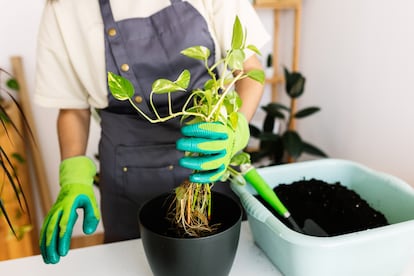
To gain confidence with this asexual reproduction, in which the reproductive organs of the plant do not intervene, it is a good idea to start with herbaceous cuttings, which root more easily. They do not have hardened tissues and can even be cut many times by applying pressure with the nails. Herbaceous cuttings have a soft consistency, unlike semi-woody or woody ones, whose tissues usually have lignin, the substance that provides firmness and is responsible for the formation of wood. For this reason, many indoor plants that are more or less herbaceous are perfect to try your hand at this reproductive method, such as the pothos (Epipremnum aureum), the impatiens (Impatiens walleriana), the iresine (Iresine diffusa f. herbstii), the coleus (Coleus scutellarioides), the polka dot begonia (Begonia maculata), Swiss cheese plant (Monstera deliciosa), arrowhead plant (Syngonium podophyllum), oyster plant (Tradescantia spp.), silver tree (Pilea spp.), many peperomias (Peperomia spp.), the Swedish ivy (Plectranthus verticillatus) and the philodendrons (Philodendron spp.). You can also try with succulent plants such as the crassulas (Crassula spp.) or the sedum (Sedum spp.), which will root quickly and easily.
Of course there is much more to say about these breeding methods; for now, let it be enough to feel like the creators of plant life, to take cuttings, to divide and conquer.
Sign up for our weekly newsletter to get more English-language news coverage from EL PAÍS USA Edition
Tu suscripción se está usando en otro dispositivo
¿Quieres añadir otro usuario a tu suscripción?
Si continúas leyendo en este dispositivo, no se podrá leer en el otro.
FlechaTu suscripción se está usando en otro dispositivo y solo puedes acceder a EL PAÍS desde un dispositivo a la vez.
Si quieres compartir tu cuenta, cambia tu suscripción a la modalidad Premium, así podrás añadir otro usuario. Cada uno accederá con su propia cuenta de email, lo que os permitirá personalizar vuestra experiencia en EL PAÍS.
¿Tienes una suscripción de empresa? Accede aquí para contratar más cuentas.
En el caso de no saber quién está usando tu cuenta, te recomendamos cambiar tu contraseña aquí.
Si decides continuar compartiendo tu cuenta, este mensaje se mostrará en tu dispositivo y en el de la otra persona que está usando tu cuenta de forma indefinida, afectando a tu experiencia de lectura. Puedes consultar aquí los términos y condiciones de la suscripción digital.
More information
Últimas noticias
Most viewed
- Reinhard Genzel, Nobel laureate in physics: ‘One-minute videos will never give you the truth’
- Pablo Escobar’s hippos: A serious environmental problem, 40 years on
- Charles Dubouloz, mountaineering star, retires at 36 with a farewell tour inspired by Walter Bonatti
- Why we lost the habit of sleeping in two segments and how that changed our sense of time
- The fall of a prolific science journal exposes the billion-dollar profits of scientific publishing


